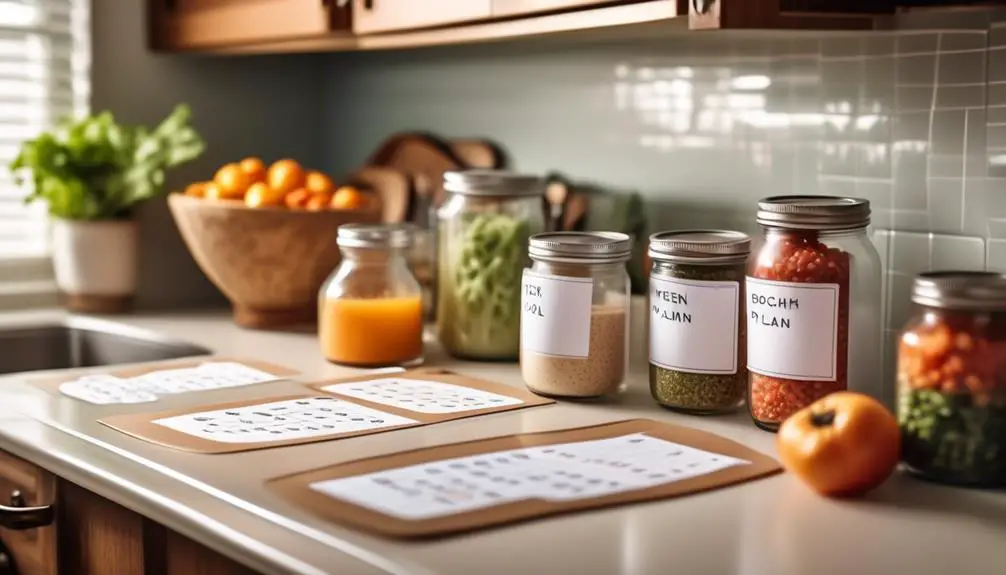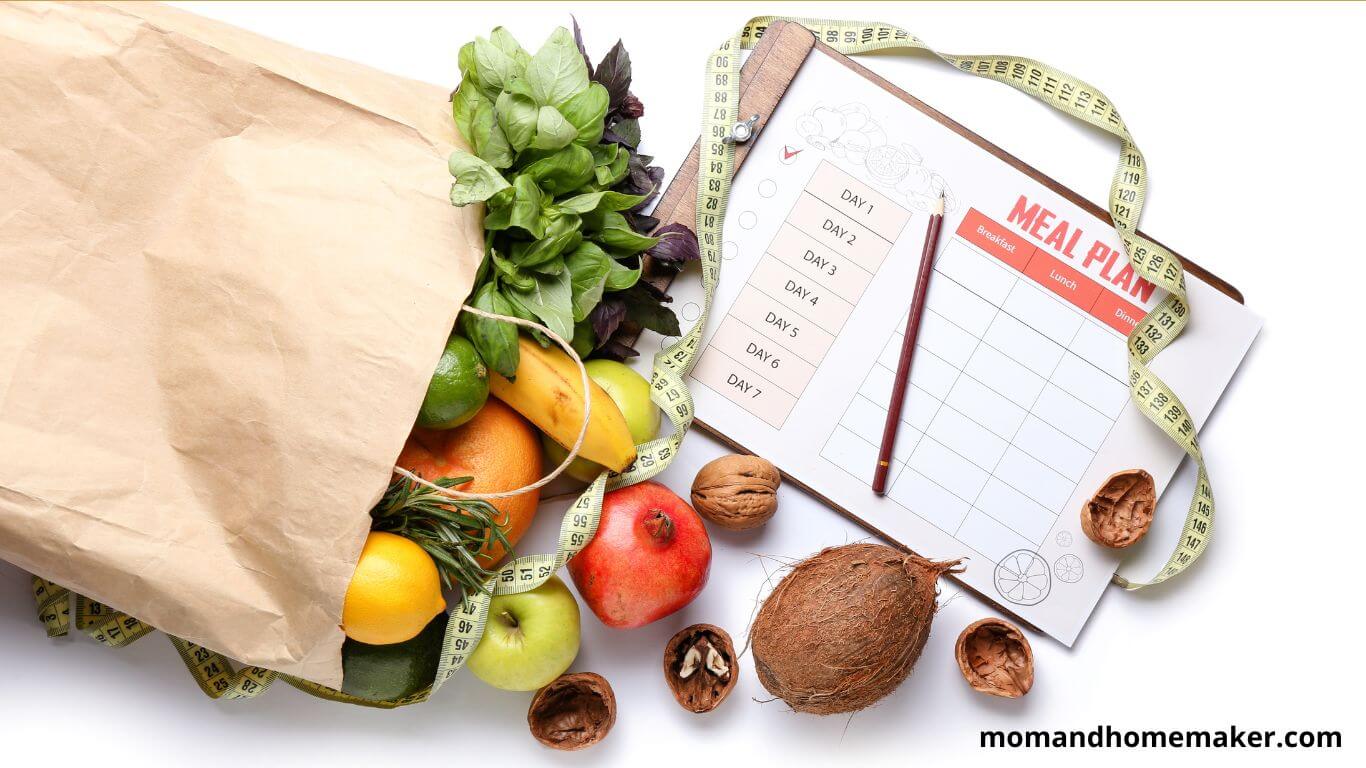Balancing the demands of daily life while also prioritizing healthy eating can be a challenge for many individuals. However, with the right time management strategies, meal planning and preparation can become more efficient and enjoyable.
In this discussion, we will identify the realm of time management as it pertains to meal planning and cooking, offering insights and practical advice to help individuals optimize their time in the kitchen and create a sustainable approach to healthy eating.
Prioritize Your Meals
To effectively prioritize your meals, start by identifying your nutritional needs and personal preferences. Meal selection is key to ensuring that you provide your body with the necessary nutrients it needs to function at its best. Consider the types of foods you enjoy and what will keep you feeling satisfied throughout the day. This will help you create a meal plan that aligns with your goals and preferences.
When it comes to time allocation, it’s important to consider how much time you have available for meal preparation. If you have a busy schedule, you may need to opt for quick and easy meals that can be prepared in a short amount of time. Look for recipes that require minimal ingredients and take less time to cook. This will help you save time in the kitchen and still enjoy a nutritious meal.
On the other hand, if you have more time available, you can experiment with more elaborate recipes that require longer cooking times. This can be a great opportunity to try out new dishes and expand your culinary skills. Plan by setting aside specific times for meal preparation to ensure that you have enough time to cook and enjoy your meals without feeling rushed.
Set Specific Meal Planning Goals
Setting specific meal planning goals is essential for creating an effective and personalized meal plan that meets your nutritional needs and preferences. By clearly defining your goals, you can ensure that your meal plan aligns with your health objectives and tastes. This will help you stay organized and make choices that support your overall well-being.
One of the biggest advantages of meal planning is its ability to promote healthier eating habits. By planning your meals, you can incorporate a variety of nutritious foods into your diet, such as fresh fruits, vegetables, whole grains, and lean proteins.
This ensures that you’re providing your body with the essential nutrients it needs to function optimally. Additionally, meal planning allows you to control portion sizes and avoid the temptation of unhealthy fast food or processed meals.
Meal planning also saves you valuable time and money. By planning your meals ahead of time, you can make the most of your time by preparing ingredients in advance and cooking in batches. This reduces the time you spend in the kitchen during busy weekdays. Moreover, meal planning enables you to create a shopping list based on your planned meals, helping you avoid unnecessary purchases and ultimately saving money.
When setting your meal planning goals, consider your specific dietary needs and preferences. Are you aiming to lose weight, build muscle, or maintain a healthy lifestyle? Do you have any dietary restrictions or allergies to consider?
Once you’ve identified your goals, you can create a meal plan that includes a variety of foods that meet your needs. You can also set goals related to portion control, meal frequency, or even trying out new recipes.
Create a Weekly Meal Schedule
Creating a weekly meal schedule can simplify your life and help you make healthier choices. By planning your meals, you can save time and reduce stress. Plus, you’ll have nutritious meals ready to go whenever you need them.
To create your weekly meal schedule, start by considering your weekly routine and any special events or commitments you have. Think about what meals you want to prepare and when you have the time and energy to cook. Take a look at the ingredients you already have in your pantry and make a grocery list of what you need to buy.
Here’s an example of a simple and delicious weekly meal schedule to get you started:
| Day | Breakfast | Lunch | Dinner |
|---|---|---|---|
| Monday | Avocado toast | Chicken salad | Grilled salmon |
| Tuesday | Veggie omelette | Quinoa bowl | Stir-fry tofu |
| Wednesday | Greek yogurt | Lentil soup | Pasta Primavera |
| Thursday | Overnight oats | Baked Chicken | Pasta primavera |
Feel free to adjust this meal schedule based on your preferences and dietary needs. The key is to have a plan in place that allows for flexibility. If you’re not in the mood for a certain meal, you can easily switch it with another option from the same day. This flexibility ensures that you can still enjoy your meals while sticking to your weekly meal plan.
Remember to keep things simple and balanced. Include a variety of fruits, vegetables, whole grains, and lean proteins in your meals. And don’t forget to stay hydrated throughout the day by drinking plenty of water. With a well-planned weekly meal schedule, you’ll be on your way to a healthier and more organized lifestyle.
Make a Detailed Grocery List
When creating a detailed grocery list, it’s important to prioritize the essential ingredients needed for your planned meals. This will ensure that you have everything you need to efficiently prepare your meals and save time during the cooking process.
To get started, take a look at the recipes you plan to make and make a note of all the ingredients required for each dish. Organizing your list by category, such as produce, pantry staples, dairy, and proteins, will make your shopping trip more efficient.
While creating your grocery list, you might also want to consider trying out new recipes. This can help add variety to your meals and prevent boredom from eating the same dishes over and over again. Look for recipe ideas online or in cookbooks that align with your dietary preferences and include ingredients you already have in your pantry. By doing this, you can make use of what you already have and reduce food waste.
Another important aspect to consider when making your grocery list is finding budget-friendly options. Eating healthy and delicious meals doesn’t have to be expensive. Look out for sales, discounts, and coupons that can help you save money on groceries. Consider substituting expensive ingredients with more affordable alternatives without compromising on taste or nutritional value.
It’s also worth mentioning that planning your meals can help you stay organized and save time. Take some time each week to plan out your meals and create a corresponding grocery list. This will ensure that you have all the necessary ingredients on hand and can avoid last-minute trips to the store.
Utilize Batch Cooking Techniques
To make your meal planning and preparation more efficient, try incorporating batch cooking techniques. Batch cooking involves preparing larger amounts of food at once and then dividing it into portions for future meals. This approach can be a game-changer when it comes to saving time and effort in the kitchen.
Here are three reasons why you should start using batch cooking techniques:
- Save Time: One of the biggest advantages of batch cooking is the time it saves you in the long run. By spending a few hours on a weekend or a free day to cook multiple meals at once, you can eliminate the need to cook from scratch every day. This means less time spent chopping, peeling, and sautéing throughout the week, allowing you to focus on other important tasks or simply relax and enjoy some well-deserved downtime.
- Reduce Stress: Meal planning can be overwhelming, especially when you have a busy schedule. Batch cooking helps alleviate this stress by providing you with pre-prepared meals that are ready to go. You no longer have to scramble to figure out what to cook each day or worry about having all the ingredients on hand. With batch cooking, you have a stash of homemade meals that can be easily reheated and enjoyed, giving you peace of mind and reducing mealtime stress.
- Promote Healthy Eating: Batch cooking allows you to have control over the ingredients used in your meals and ensures that you always have nutritious options available. By preparing larger portions of wholesome, balanced meals, you can avoid relying on unhealthy takeout or processed convenience foods when you’re short on time. This not only benefits your overall health but also helps you save money in the long run.
Incorporating batch cooking techniques into your meal-planning routine can be a game-changer. By saving time, reducing stress, and promoting healthy eating, you’ll be able to enjoy delicious, home-cooked meals without sacrificing precious time or energy in the kitchen. Give it a try and experience the benefits for yourself!
Prep Ingredients in Advance
Save time and make your meal preparation easier by prepping your ingredients in advance. This simple strategy can help you stay organized in the kitchen and streamline the cooking process.
One of the best time-saving tips is to chop and cut your vegetables and fruits ahead of time. Take some time when you have a free moment and chop up a variety of vegetables that you often use in your recipes.
Store them in meal prep containers and keep them in the fridge until you need them. This way, when it’s time to cook, you can simply grab the container and start cooking without wasting time on chopping and cleaning.
Another great idea is to prep your protein in advance. Whether it’s chicken, beef, or fish, you can marinate and portion it out ahead of time. This way, you’ll always have ready-to-cook protein whenever you need it. You can also precook proteins like chicken or ground meat and store them in meal prep containers. This will save you cooking time during the week and make it easier to put together meals.
Additionally, consider mixing and measuring dry ingredients for recipes that you frequently use. By doing this, you can save time by not having to measure each ingredient separately every time you cook. Simply grab the pre-measured dry ingredient mixture and add it to your recipe.
Prepping ingredients in advance not only saves time but also helps you stay on track with your healthy eating goals. With everything ready to go, you’re more likely to cook at home instead of relying on takeout or processed meals.
Optimize Kitchen Organization
To optimize your kitchen organization and make it more efficient, you can implement smart storage solutions. A well-organized kitchen not only saves you time but also creates a sense of belonging and comfort.
Here are three effective ways to maximize efficiency and optimize storage in your kitchen:
- Use vertical space: Take advantage of the vertical space in your kitchen by installing shelves, hooks, and racks. Hang pots and pans from hooks on the wall or ceiling to free up cabinet space. Installing floating shelves can be a great solution for storing spices, cookbooks, and other frequently used items. Utilizing vertical space will help keep your countertops clear and make it easier for you to access all your kitchen essentials.
- Invest in drawer organizers: Keep your drawers tidy and efficient by using drawer organizers. These handy tools help you separate and categorize your utensils, knives, and gadgets, making it easier to quickly find what you need. With everything neatly organized, you can save time and minimize frustration when preparing meals or setting the table.
- Label and group similar items: To optimize storage and maximize efficiency, label, and group similar items together. Use clear, labeled containers for pantry staples like flour, sugar, and rice. Group all baking supplies, such as measuring cups and spoons, together in one designated area. By keeping items organized and easily accessible, you’ll avoid wasting time searching for ingredients and tools.
Streamline Cooking Processes
Streamlining your cooking processes can maximize your efficiency in the kitchen and save you time. To do this, it’s important to plan and prepare your meals in advance. Take a few moments each week to create a meal plan, ensuring you have all the necessary ingredients. This eliminates the stress of last-minute decisions and saves you time.
Another time-saving tip is to prep ingredients ahead of time. Spend a few hours on the weekend chopping vegetables, marinating meats, or pre-cooking grains. This way, you can simply grab the prepped ingredients during the week and quickly assemble your meals. It significantly cuts down on meal preparation time.
Investing in time-saving appliances and tools can also streamline your cooking processes. A good quality food processor, blender, or slow cooker can handle various cooking tasks while you focus on other things or relax.
Use Meal Planning Apps or Tools
Consider using meal planning apps or tools to simplify your meal preparation process and stay organized. These convenient digital resources can save you time, money, and stress. Here are three benefits of utilizing meal-planning apps or tools:
- Efficiency: Meal planning apps or tools make it quick and easy to create meal plans for the week. You can browse through a variety of recipes, select the ones you like, and generate a shopping list with just a few clicks. This eliminates the need to search for recipes and write down ingredients manually. By having everything in one place, you can efficiently plan your meals and grocery trips, ensuring you have all the necessary ingredients on hand.
- Variety: Meal planning apps or tools often offer a wide range of recipes to cater to different dietary preferences and restrictions. Whether you’re a vegetarian, following a specific diet, or simply looking to try new dishes, these apps can provide you with countless options. This variety keeps your meals interesting and prevents you from getting stuck in a cooking rut.
- Organization: One of the key advantages of using meal planning apps or tools is the ability to stay organized. You can easily create a meal schedule, track your grocery purchases, and even set reminders for cooking times. This level of organization helps you stay on top of your meal planning and ensures that you have everything you need when it’s time to start cooking.
By incorporating meal planning apps or tools into your routine, you can simplify the meal preparation process. With their efficiency, variety, and organizational capabilities, these digital resources can help you save time, discover new recipes, and stay on top of your meal-planning game.
Incorporate Time-Saving Appliances
If you want to make your meal preparation process even more efficient, consider incorporating time-saving appliances. These appliances are designed to help you save time and energy in the kitchen. They range from simple gadgets like a food processor or a slow cooker to more advanced appliances like an Instant Pot or a sous vide machine.
By using these appliances, you can significantly reduce the time you spend on meal planning and preparation, allowing you to focus on other important aspects of your life.
One popular time-saving appliance is the Instant Pot. This multi-functional electric pressure cooker can do a wide variety of cooking tasks, such as sautéing, steaming, slow cooking, and baking. With its programmable features and fast cooking times, the Instant Pot can help you prepare meals in a fraction of the time it would take using traditional cooking methods.
Another appliance that can save you time in the kitchen is the food processor. This handy gadget can quickly chop, slice, shred, and puree ingredients, making meal preparation a breeze. Whether you’re making homemade salsa or whipping up cookie dough, a food processor can help you get the job done quickly.
Delegate Meal Preparation Tasks
To make your meal preparation process more efficient, you can assign specific tasks to other members of your household or consider using a meal preparation service. Delegating meal preparation tasks can save you time and reduce stress in the kitchen.
Here are three effective ways to delegate these tasks:
- Outsource meal prep: If you want to save time and effort, you can outsource your meal preparation to a professional service. Many companies offer pre-made meal kits or fully prepared meals that can be delivered to your door. This option allows you to focus on other important tasks or simply relax, as the planning and cooking are taken care of for you.
- Effective task delegation: If you prefer to keep meal preparation within your household, you can assign specific tasks to other family members or roommates. Divide responsibilities such as meal planning, grocery shopping, chopping vegetables, or cooking certain dishes. By sharing the workload, everyone can contribute to the meal preparation process and feel a sense of teamwork and belonging.
- Rotating meal responsibilities: Another option is to create a rotating schedule where each person takes turns being responsible for meal preparation. This ensures that everyone gets a break from cooking regularly and provides an opportunity for individuals to showcase their culinary skills and try new recipes. It can be a fun and engaging way to involve everyone in the meal planning and preparation process.
Embrace Freezer-Friendly Meals
One way to make your meal preparation process even easier is by embracing freezer-friendly meals. Freezer meal hacks can save you time and effort in the kitchen while still allowing you to enjoy tasty and nutritious meals. By preparing and freezing meals in advance, you’ll always have quick meal ideas ready to go whenever you need them.
There are a few strategies you can use when it comes to freezer meal hacks. First, try batch cooking. This means making large quantities of a meal and then dividing it into individual portions to freeze. That way, you can simply defrost and reheat a single serving whenever you’re ready to eat. It’s a fantastic way to save time and ensure you always have something delicious on hand.
Another freezer meal hack is to freeze ingredients instead of complete meals. For example, you can chop and freeze vegetables, cook and freeze grains like rice or quinoa, or even freeze cooked meats or proteins. This allows you to mix and match ingredients to create quick and easy meals whenever you need them.
Stir-fries, casseroles, and soups are all great quick meal ideas that can be made from freezer-friendly ingredients. Just defrost your ingredients, combine them in a pan or pot, and heat until warm and cooked through. You can also add fresh herbs, spices, or sauces to enhance the flavor of your meals.
With freezer-friendly meals, you can simplify your meal prep and always have delicious and nutritious options at your fingertips. Give these freezer meal hacks a try and see how they can make your life in the kitchen a whole lot easier.
Plan for Leftovers and Repurposing
To make your meal planning and preparation even easier, consider using leftovers and repurposing ingredients. This not only saves you time and money but also ensures that no food goes to waste. Here are three ways to make the most of your leftovers and get creative with your meal planning:
- Storing leftovers: Invest in high-quality food storage containers to keep your leftovers fresh and organized. Label them with the date and contents for easy identification. Clear containers are especially helpful as you can see what’s inside at a glance. By storing your leftovers properly, you can easily incorporate them into your meal plan for the week and avoid any last-minute food waste.
- Getting creative with recipes: Don’t let your leftovers sit in the fridge untouched. Instead, let your imagination run wild and transform them into new and exciting dishes. For example, you can shred leftover roasted chicken and use it in tacos or add it to a salad. Mashed potatoes can be turned into potato pancakes or used as a topping for shepherd’s pie. With a little creativity, you can turn your leftovers into mouthwatering meals that your family will love.
- Repurposing ingredients: Look for ways to repurpose ingredients from one meal to the next. If you have leftover vegetables from a stir-fry, you can use them in a frittata or omelet the next day. Leftover cooked rice can be transformed into fried rice or added to soups and stews. By repurposing ingredients, you not only save time but also add variety to your meals.
Take Advantage of Meal Delivery Services
Simplify your meal planning and preparation by taking advantage of meal delivery services. These services offer a convenient way to have delicious and nutritious meals ready to enjoy without the hassle of cooking. If you’re struggling to find time for meal planning and cooking, meal delivery services can be a game-changer.
One of the main benefits of using a meal delivery service is that it saves you time. Instead of spending hours every week planning meals, grocery shopping, and cooking, you can simply choose from a variety of pre-packaged meals that suit your preferences and dietary needs.
These services offer options like vegetarian, vegan, gluten-free, and low-carb meals. With just a few clicks, you can have a week’s worth of meals delivered right to your doorstep.
Another advantage of meal delivery services is that they provide meal planning tips and cooking shortcuts. Many services offer detailed instructions on how to prepare the meals, including cooking times and temperatures. Some even provide video tutorials to help you with the cooking process. This can be especially helpful for those who are new to cooking or don’t have much experience in the kitchen.
Meal delivery services also allow you to try new and exciting dishes without the fear of messing up the recipe. You can explore different cuisines and flavors without having to worry about buying a long list of ingredients or spending hours in the kitchen. It’s a great way to expand your culinary horizons and discover new favorite meals.
Stay Flexible and Adapt Your Plan as Needed
Being flexible and adapting your meal planning and preparation plan is crucial for effectively managing your time and achieving your dietary goals. Life is unpredictable, and sometimes things don’t go as planned. That’s why it’s important to stay flexible and be ready to adjust your plan as needed.
Here are three reasons why staying flexible and adapting your plan can lead to success:
- Embrace Change: Unexpected events can arise in life, such as last-minute work meetings or social gatherings. Instead of letting these events derail your meal plan, embrace the change and find alternative solutions. You can swap meals around, prep ingredients in advance, or even choose a quick and healthy takeout option. By staying flexible, you can easily modify your plan without feeling overwhelmed or defeated.
- Optimize Resources: Occasionally, certain ingredients may not be available or within your budget. Rather than rigidly sticking to your original plan, adapt it by substituting ingredients or finding creative alternatives. This flexibility allows you to make the most of what you have on hand, reducing waste and saving money. It also opens up opportunities to explore new recipes and flavors.
- Listen to Your Body: Your body’s needs can vary from day to day. If you’ve planned a heavy and elaborate dinner but find yourself craving something lighter, it’s important to listen to your body and adjust your plan accordingly. By staying flexible, you can honor your body’s signals and make choices that align with your overall well-being.
Conclusion
By following these time management strategies for meal planning and preparation, you’ll become a pro at effortlessly creating delicious and nutritious meals in no time.
You will be free from stressful last-minute cooking and hello to a well-organized and efficient kitchen. With these strategies, you’ll feel like a superhero in the kitchen, saving time, reducing stress, and enjoying more quality meals with your loved ones.






